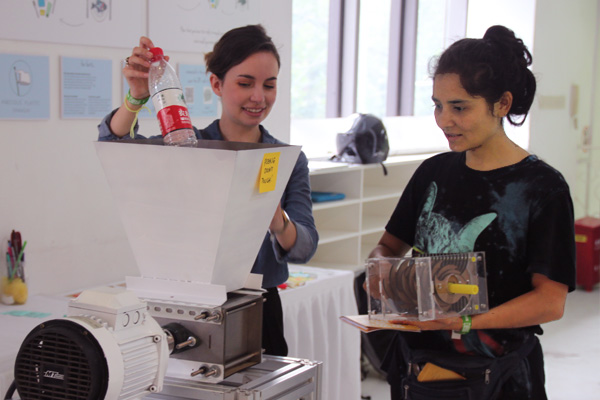More than two billion tons of solid waste is generated every year by the world’s cities — a challenge that if left unaddressed, will continue to have serious health, safety and environmental consequences. This semester, nine IMA students accepted the challenge of “learning everything about plastic and plastic pollution” and finding ways to sustainably upcycle it in a new course, Re-Made in China.
“Our goal is to become as knowledgeable as possible about our subject, and to come up with viable project ideas and prototypes that can be sustainable and fair business models generating a positive social impact for local communities,” says Clinical Instructor of Arts Marcela Godoy.
The two-credit course, guided by the principles of sustainable design philosophy, will introduce students to both traditional and new technologies to address social and environmental problems. The goal is to remake plastic waste into “something valuable and even extraordinary,” be it accessories, handcrafts or an art project.

(The first class on Oct 25)
In class, students are divided into 3 groups: one focusing on developing machines to process plastic, such as shredding and melting; another experimenting with what materials plastic can be transformed into; and the third on designing new products. “I want students to work together like a design firm, where we learn about plastic together and collaborate on projects,” Godoy says.
Suhyeon Lee ‘19, who took Godoy’s class on Digital Fabrication last semester and has signed on for Remade in China, says she is excited about learning what can be done with the overflow of trash. “I am going to gather discarded materials and combine them to produce an object that we can enjoy again -- either an artistic sculpture, musical instrument, daily necessity, or even something personal that is meaningful to someone.”

(Marcela Godoy on the right, showing how to use the plastic shredder that she built)
Godoy’s idea of recycling emerged in 2012, when she was working in New York at YesYesNo, a studio for interactive arts and technology projects. She noticed the huge amount of waste generated from projects, and decided to upcycle the materials to make necklaces and other accessories.
“How ironic that things to make people feel beautiful can be made out of the opposite,” she says.
Godoy is encouraging her students to become even more deeply engaged with the community they live in, by assigning projects that take them out of the classroom, such as creating “trash maps” tracking plastic trash routes through Shanghai.
“I am going to invite a person who collects recyclables from trash in Shanghai to share his experience,” Godoy says, “Students will then be assigned to research and interview people on their own to find out where the plastic trash is produced and disposed of.”
Godoy also plans to invite seasoned designers from Precious Plastic Shanghai, a social enterprise devoted to raising plastic pollution awareness in China, to offer hands-on coaching to students in a workshop later in November. Godoy worked with the team after moving to China in 2015.
At the end of the course, Godoy plans to launch a “Re-Maker Space” for the benefit of the whole NYU Shanghai community, where all students and faculty can drop by to process plastic and make something valuable of their own.
The seven-week course is expected to conclude on December 11. Following the end of the semester, Godoy will present her class’ work at the Precious Plastic WANA Conference in Abu Dhabi on December 16-17.


